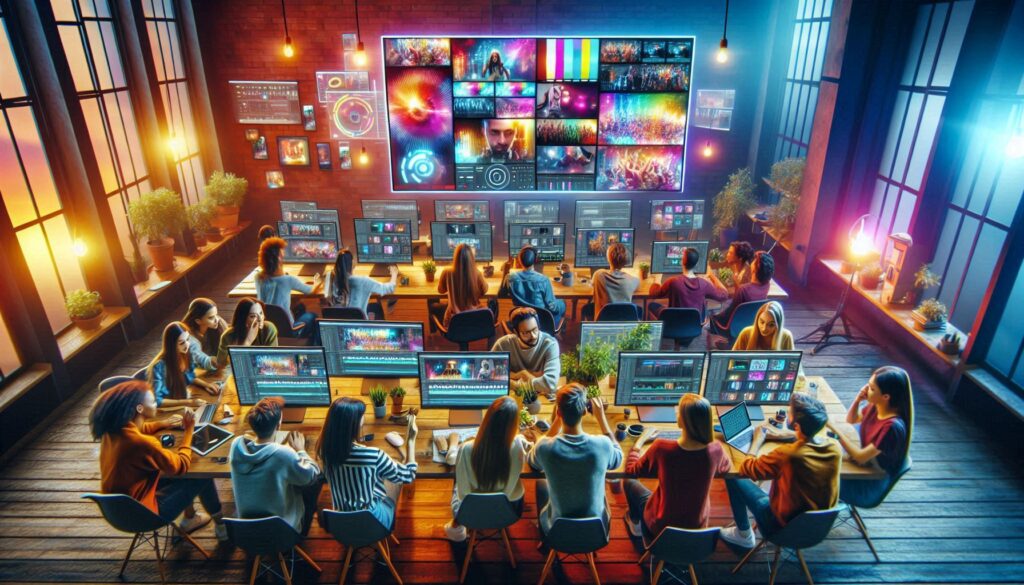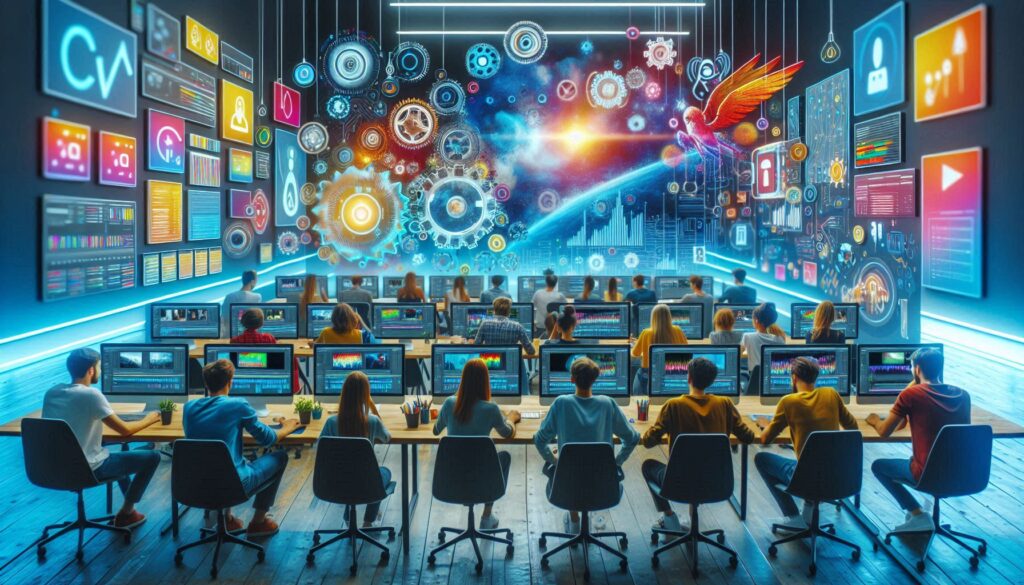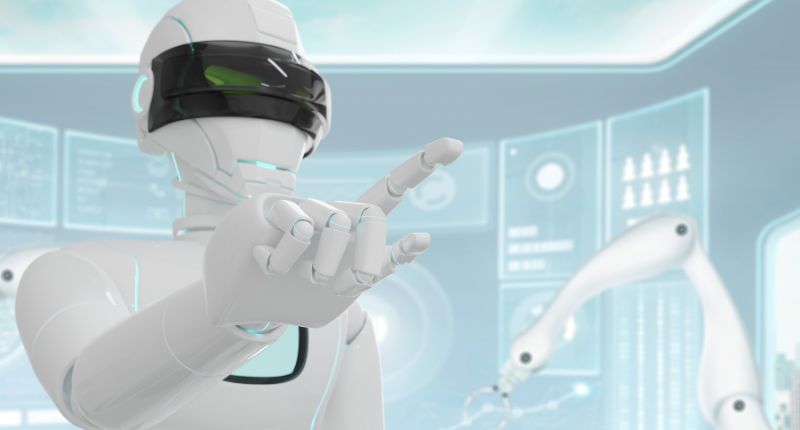Video editing has come a long way from the days of splicing film and manual edits. Today, the emergence of Artificial Intelligence (AI) has revolutionized the way creators approach video production. AI-powered tools are not only streamlining workflows but are also enabling creators to achieve professional-grade edits with minimal effort. Whether you’re a seasoned filmmaker or a content creator just starting, AI tools can dramatically enhance your editing process.
In this article, we will explore how AI is transforming video editing, discuss some of the best AI tools available, and provide tips on integrating them into your workflow. Let’s explore Video Editing with AI Tools
The Rise of AI in Video Editing
Artificial Intelligence has permeated almost every industry, and video editing is no exception. AI tools leverage machine learning and advanced algorithms to understand and manipulate video content. These tools can recognize objects, faces, and scenes, automate time-consuming tasks, and even suggest creative edits.
Benefits of Using AI in Video Editing
- Efficiency: AI tools save hours of manual editing by automating tasks such as trimming, color correction, and audio balancing.
- Consistency: AI ensures consistent results across videos, especially useful for creators with branded content.
- Accessibility: Even users with little to no editing experience can create professional-quality videos using AI tools.
- Cost-Effectiveness: By speeding up workflows and reducing reliance on multiple tools, AI editing can reduce production costs.
Top AI Tools for Video Editing
Here’s a curated list of AI-powered tools that can elevate your video editing game:

1. Adobe Premiere Pro with Adobe Sensei
Adobe Premiere Pro has integrated Adobe Sensei, an AI framework that automates mundane tasks. Features like auto-reframe for social media and Lumetri color matching are powered by AI, saving hours of manual work.
- Key Features:
- Automatic scene detection.
- Smart color grading.
- Audio noise reduction.
2. Runway ML
Runway ML offers intuitive tools for creators to leverage AI in video editing. From removing backgrounds to generating custom effects, it’s a versatile platform for artists and editors.
- Key Features:
- AI-based object removal.
- Text-to-video capabilities.
- Real-time collaboration tools.
3. Descript
Descript is perfect for video and podcast creators. Its standout feature is the ability to edit videos by editing the script, making it easier to cut or refine content.
- Key Features:
- Overdub for voiceovers.
- Screen recording with transcription.
- Automatic subtitle generation.
4. Magisto
Magisto, powered by Vimeo, is a user-friendly AI video editor tailored for businesses and social media creators. It analyzes your footage and creates videos optimized for your audience.
- Key Features:
- Pre-designed templates.
- Smart music selection.
- Advanced analytics integration.
5. Pictory AI
Pictory AI is designed for converting long-form content into short, engaging videos. It’s ideal for repurposing webinars, podcasts, and blog posts.
- Key Features:
- Auto video summarization.
- Caption generation.
- Royalty-free music library.
6. Topaz Video Enhance AI
This tool focuses on video enhancement, enabling upscaling, deinterlacing, and restoring old footage with stunning clarity.
- Key Features:
- AI upscaling to 4K or 8K.
- Noise and grain reduction.
- Frame rate conversion.
7. Wisecut
Wisecut is a smart tool for video creators who want to produce quick, professional-looking edits. It automates tasks like cutting silences and syncing subtitles.
- Key Features:
- Automatic silence removal.
- Background music integration.
- Voice-to-text transcription.
Key Applications of AI in Video Editing
AI isn’t just about automating tasks; it also enhances creativity. Here are some specific applications:
1. Automated Scene Detection
AI can analyze video footage and break it into scenes, helping editors focus on refining specific segments without manually searching for scene transitions.
2. Smart Color Grading
Color grading is critical for setting the tone and mood of a video. AI tools analyze the footage and apply color adjustments that complement the scene, reducing the need for manual tweaks.
3. Object and Background Removal
Removing unwanted objects or changing backgrounds has become a breeze with AI. Tools like Runway ML and Adobe Premiere Pro can isolate objects and seamlessly remove or replace them.
4. Subtitling and Captioning
AI tools automatically generate subtitles and captions with remarkable accuracy. This is especially useful for creators targeting a global audience.
5. Audio Enhancement
AI-powered audio tools can remove noise, balance levels, and even generate background music that matches the mood of your video.
6. Content Summarization
For longer videos, AI can identify key highlights and create a concise summary, ideal for promotional materials or social media.
7. AI-Generated Effects
Some tools offer AI-driven effects, like slow-motion generation or style transfer, allowing creators to experiment with unique visuals.
How to Integrate AI Tools Into Your Workflow
1. Identify Your Needs
Not every project requires advanced AI tools. Start by identifying the specific challenges in your workflow, such as tedious manual edits or lack of creative ideas.
2. Choose the Right Tool
Research and select tools that align with your requirements. For instance, if you frequently create content for social media, a tool like Magisto or Descript could be ideal.
3. Experiment with Features
Spend time exploring the features of your chosen tool. Many AI editors offer free trials, giving you a risk-free way to test their capabilities.
4. Optimize Workflow
Integrate AI tools with your existing software to streamline your workflow. Many AI platforms support plugins or integrations with popular editing suites.
5. Stay Updated
AI tools evolve rapidly. Stay informed about updates and new features to ensure you’re leveraging the latest advancements.
Tips for Maximizing AI in Video Editing
- Use Templates Wisely: Many AI tools offer pre-designed templates. Customize them to align with your brand’s style.
- Combine Tools: Don’t rely on a single tool. Combine AI tools with traditional editing software for maximum flexibility.
- Review Edits: While AI is powerful, it’s not infallible. Always review automated edits to ensure they meet your standards.
- Focus on Storytelling: AI can handle technical aspects, but storytelling remains a human skill. Focus on creating compelling narratives.
Challenges and Limitations
While AI tools are transformative, they aren’t without challenges:
- Learning Curve: Some tools require time to learn, especially for beginners.
- Creative Limitations: AI can automate tasks, but creative decisions still require human input.
- Cost: Advanced tools may require a subscription or one-time payment, which might not fit every budget.
- Dependence on Data: AI relies on data for training. Poor-quality footage or unclear instructions can lead to subpar results.
The Future of AI in Video Editing
The integration of AI in video editing is just the beginning. Future advancements could include real-time editing during live broadcasts, AI-powered storyboarding, and even virtual reality-based editing tools. As AI continues to evolve, the boundaries of creativity and efficiency will be pushed further.
Real-World Use Cases of AI in Video Editing
To better understand the potential of AI in video editing, let’s explore some real-world scenarios where AI tools have been game-changers:
1. Social Media Content Creation
Social media platforms thrive on engaging videos. AI tools like Magisto and Pictory AI help small businesses and influencers create high-quality videos tailored for platforms like Instagram, TikTok, and YouTube. These tools automate tasks like scene cropping, adding captions, and music selection, enabling creators to produce viral content quickly.
2. Film and Television
In the film and television industry, AI is used for complex tasks such as CGI integration, special effects, and color grading. For instance, AI-based software can match the color tones across different shots to maintain visual continuity. AI has also been employed in de-aging actors, as seen in major Hollywood productions.
3. Educational Content
Educational institutions and online learning platforms use AI tools to enhance video lectures. Automated subtitling, visual aids, and background replacement make learning materials more engaging. Tools like Descript can also help educators refine their content by editing out filler words and pauses.
4. Marketing Campaigns
Marketing teams leverage AI to create promotional videos that resonate with target audiences. AI tools analyze user data to suggest video formats, themes, and even the type of music that would perform best with a specific demographic.
5. Archiving and Restoration
For historical footage or old films, AI tools like Topaz Video Enhance AI are used to upscale low-resolution videos and restore damaged frames. This has been instrumental in preserving cinematic history and enabling it to be viewed on modern screens.
How AI is Democratizing Video Editing
One of the most significant impacts of AI in video editing is its ability to democratize the process. Previously, professional-grade editing required expensive software, high-end hardware, and years of experience. Today, AI tools bring these capabilities to anyone with a computer or smartphone.
Accessibility for Beginners
Platforms like Canva and CapCut offer AI-powered video editing features that even beginners can use. These platforms include drag-and-drop interfaces, pre-made templates, and automated edits, allowing users to create professional-looking videos without prior experience.
Empowering Small Businesses
Small businesses often lack the resources for extensive video production. AI tools level the playing field by enabling them to produce high-quality advertisements, product demos, and social media content without hiring professionals.
Freelancers and Independent Creators
Freelancers and independent creators benefit greatly from AI tools. They can take on more projects and deliver results faster, improving their earning potential and efficiency.
AI and Ethical Considerations in Video Editing
While AI offers numerous benefits, it also raises ethical questions:
1. Deepfake Concerns
AI tools capable of generating deepfake videos have sparked debates about their ethical implications. These videos can be used for misinformation, fraud, or manipulation.
2. Copyright Issues
AI tools often use pre-existing data to train their algorithms. This raises questions about copyright infringement, particularly when using AI-generated music or effects.
3. Job Displacement
As AI automates more tasks, there is a concern about job displacement for traditional video editors. However, experts argue that AI will augment rather than replace human creativity.
4. Bias in AI Algorithms
AI algorithms can inherit biases from their training data. For example, facial recognition AI might not perform equally well across different ethnicities. Ensuring fairness in AI tools is an ongoing challenge.
The Role of Human Creativity
While AI excels at automation, it cannot replace human creativity. Video editing is not just about technical precision; it’s about storytelling, emotion, and vision. AI serves as a powerful assistant, but the creative direction still lies with the editor.
Adding the Human Touch
- Emotional Connection: AI tools can suggest edits, but they cannot gauge the emotional tone you want to convey.
- Unique Style: AI may provide templates and effects, but a creator’s unique style and perspective make a video stand out.
- Adaptability: Human editors can adapt to unforeseen challenges or specific client requests in ways AI cannot.
Collaboration Between AI and Humans
The most effective workflows combine human creativity with AI efficiency. For example:
- Use AI for initial edits, like trimming and color grading.
- Refine the edits manually to add a personal touch.
- Experiment with AI-generated effects to enhance creativity.
What’s Next for AI in Video Editing?
The future of AI in video editing is exciting and full of possibilities. Here are some trends to watch:
1. Real-Time Editing
AI advancements may soon enable real-time video editing during live events or broadcasts, making it easier to produce polished content on the fly.
2. Personalized Content
AI could analyze viewer preferences and create personalized video content tailored to individual tastes.
3. Enhanced Collaboration
As remote work becomes more common, AI tools will likely focus on improving collaborative features, such as real-time co-editing and cloud-based workflows.
4. Virtual Reality (VR) Editing
AI will play a crucial role in editing VR and augmented reality (AR) content, helping creators navigate the complexities of these immersive formats.
Final Thoughts
The integration of AI into video editing is a game-changer, offering unprecedented levels of efficiency, accessibility, and creativity. From automating tedious tasks to enabling innovative effects, AI tools are empowering creators to focus on storytelling and artistry.
Whether you’re a beginner looking to create your first video or a professional seeking to streamline your workflow, AI tools can supercharge your video editing journey. By embracing these technologies, you can unlock new possibilities and stay ahead in the ever-evolving world of content creation.
So, why wait? Start exploring AI video editing tools today, and let your creativity soar!
Conclusion: Video Editing with AI Tools
AI has transformed video editing, making it more accessible, efficient, and creative. From automating tedious tasks to generating professional-grade edits, AI tools are empowering creators to focus on what truly matters—storytelling. Whether you’re an aspiring YouTuber or a seasoned filmmaker, integrating AI into your workflow can supercharge your editing process and take your content to the next level.
Embrace the power of AI and start experimenting with these tools today. Your next masterpiece is just a few clicks away!
Looking to create professional videos effortlessly? Check out our detailed Synthesia.io Review to see how this AI-powered platform is revolutionizing video content creation with its innovative features and ease of use.


